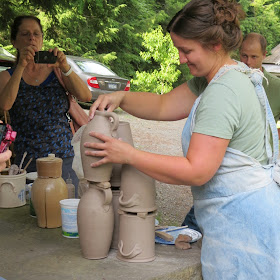My hope to have this posted mid-week last week clearly did not happen. Another part of my traveling adventure last weekend was to Don Carpentier's Eastfield Village in Upstate New York.
Each year, Eastfield Village hosts a series of lectures and workshops centered around various aspects of the structures and collections there. One such weekend is generally focused on ceramics of one kind or another, and is fondly called by many, "Dish Camp." It is a great experience that is unlike any conference. It's a laid back environment with presentations in an historic church. People bring archaeological material as well as intact pots to talk about various things or to get other opinions on what they have. The lectures are by people from various aspects of the ceramics world- collectors, scholars, researchers, archaeologists, enthusiasts- and it makes for a great weekend of learning and camaraderie.
I had the pleasure of presenting some of my newer research on Kentucky and Ohio River Valley pottery production There were some great speakers this year talking about a variety of things from archaeological adventures in Burslem, England to new aspects on Philadelphia-made earthenwares.
Rick Hamlin from Massachusetts came to talk with Dave Graci about Whately pottery, and he also demonstrated a few pottery making techniques.
I did a pottery demonstration, but also demonstrated how kiln furniture functioned in the kiln as well as a demonstration of stacking pots with kiln furniture.
One thing I try to make sure to point out during a demonstration is how the thickness of the walls vary and also that the heft of an historic pot is not always because the potter could not throw well. It also had to do a lot with the clay and whether it had enough plasticity to have high walls, or absorbed water and slumped some at the bottom making for thicker foot profiles.
Each Saturday evening attendees are treated to a period meal cooked by kitchen demonstrators from Old Sturbridge Village. Dinner is served in the historic tavern on site, and often accompanied by music!
 |
| I tend to have shop envy when I visit Don's shop! |
 |
| Don showing how the engine turning lathe operates |










No comments:
Post a Comment
I would love to know your thoughts!
Please share and create a conversation!